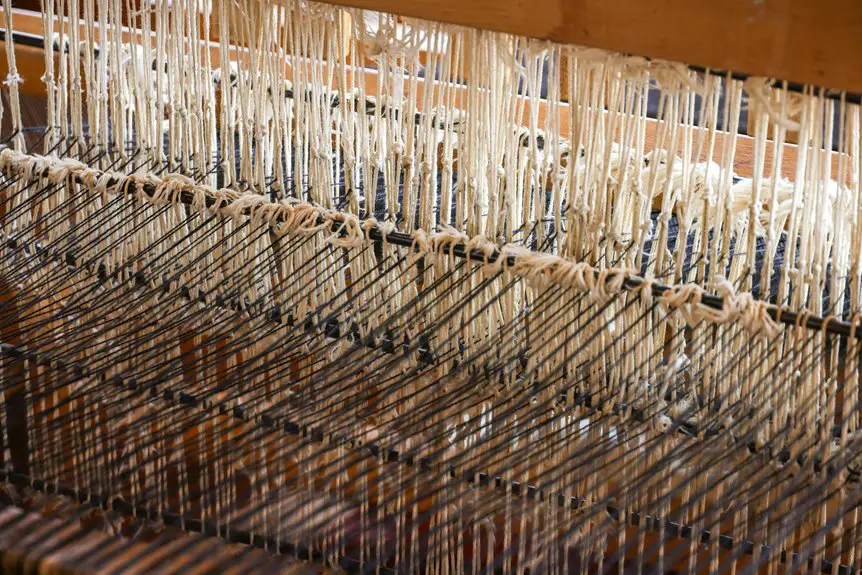When choosing poly-cotton fabric, you’ll find twill offers a durable, wrinkle-resistant weave with a diagonal pattern that’s great for heavy use and a softer drape. Poplin, on the other hand, feels smooth, crisp, and lightweight, making it perfect for breathable shirts or dresses. Both resist shrinking and fading well, but twill is sturdier, while poplin feels cooler. If you want to understand how these weaves impact comfort, appearance, and care for your project, there’s more to explore.
Table of Contents
Key Takeaways
- Poly-cotton twill features a diagonal weave, offering durability, wrinkle resistance, and a soft drape ideal for workwear and casual apparel.
- Poly-cotton poplin has a fine, plain weave with a smooth, crisp surface, making it breathable and perfect for shirts, dresses, and bed linens.
- Twill’s diagonal pattern provides extra strength and better tear resistance than poplin, suitable for heavy-use applications.
- Poplin offers lighter weight and higher breathability, making it comfortable for warm weather garments.
- Both weaves require gentle washing and low heat drying to maintain fabric integrity and appearance.
Understanding Poly-Cotton Blends
Poly-cotton blends combine the best qualities of polyester and cotton fibers to create fabrics that are durable, breathable, and easy to care for.
When you choose poly-cotton, you get the softness and natural feel of cotton paired with polyester’s strength and wrinkle resistance. This blend resists shrinking and fading, so your clothes and textiles maintain their look and fit longer.
You’ll appreciate how poly-cotton dries quickly and requires less ironing, making it ideal for busy lifestyles. Whether for clothing, bedding, or uniforms, understanding this blend helps you pick fabrics that balance comfort with practicality.
Key Characteristics of Twill Weave
Twill weave stands out for its distinctive diagonal pattern, which you can easily spot on many poly-cotton fabrics. This pattern results from the weaving technique where the weft thread passes over one or more warp threads, then under two or more, creating those angled lines.
When you touch twill, you’ll notice its durability and resistance to wrinkles, making it ideal for everyday wear and work clothes. It also drapes well, giving garments a comfortable fit without stiffness.
You’ll find twill fabrics tend to be thicker and more opaque than plain weaves, offering better protection and longevity. Plus, twill’s texture hides stains and soil better, so your clothing stays looking cleaner longer.
All these features make twill weave a practical, stylish choice in poly-cotton blends.
Key Characteristics of Poplin Weave
While twill weave offers durability and texture, poplin weave brings a different set of qualities that you might appreciate for lighter, more breathable garments. Poplin features a plain weave with fine, closely packed yarns, giving it a smooth surface and crisp feel. It’s ideal for shirts and dresses where comfort and appearance matter. You’ll notice it resists wrinkles well, yet feels soft against your skin.
| Attribute | Poplin Weave |
|---|---|
| Texture | Smooth and crisp |
| Breathability | High |
| Weight | Lightweight |
| Wrinkle Resistance | Moderate to good |
Comparing Durability Between Twill and Poplin
When you compare twill and poplin, you’ll notice twill’s diagonal weave gives it extra strength for heavy use.
Poplin, on the other hand, resists wear well thanks to its tight, plain weave.
Understanding these differences helps you choose the right fabric for your needs.
Twill Fabric Strength
Understanding fabric strength matters when choosing between twill and poplin for your projects.
Twill fabric stands out because of its distinctive diagonal weave, which gives it a tighter, more durable structure. When you pick twill, you’re getting a fabric that resists tears and withstands heavy use better than poplin. This strength makes twill a popular choice for workwear, upholstery, and items that face rough handling.
You’ll notice twill holds up well over time, maintaining its shape and integrity through repeated wear and washing. While poplin is lighter and smoother, twill’s robust weave means it can handle more stress without losing its form.
Poplin Wear Resistance
Anyone looking for a lightweight fabric that balances comfort and durability will find poplin an interesting option.
Poplin features a tight plain weave, which gives it a smooth surface and decent resistance to wear. While it’s not as rugged as twill, poplin holds up well to everyday use and repeated washing without significant fraying or thinning. You’ll notice poplin resists pilling and maintains its structure better than many other lightweight fabrics.
However, if your application demands heavy abrasion resistance, twill might outperform poplin due to its diagonal weave and thicker yarns.
Still, for garments requiring a crisp, smooth finish with moderate durability, poplin offers a good balance. It’s a smart choice when you want something lighter but still reasonably tough.
Texture and Appearance Differences
Texture plays an essential role in how poly-cotton fabrics feel and look. When you touch twill, you’ll notice its diagonal weave creates a slightly raised, textured surface that feels more substantial and durable. This weave gives twill a subtle sheen and depth, making it visually richer and more complex.
On the other hand, poplin’s plain weave results in a smooth, flat texture that feels lighter and crisper against your skin. Its tightly woven surface offers a matte finish, giving poplin a clean, polished appearance.
You’ll find twill looks more textured and heavyweight, while poplin appears finer and more uniform. Understanding these differences helps you choose the right fabric based on the tactile experience and visual style you want for your project.
Common Uses for Twill Poly-Cotton Fabric
You’ll find twill poly-cotton fabric in workwear and uniforms thanks to its durability and comfort.
It’s also popular for casual apparel styles that need a sleek yet sturdy look.
Plus, twill works well in home décor applications like curtains and cushions, adding both texture and strength.
Workwear and Uniforms
Durability makes twill poly-cotton fabric a top choice for workwear and uniforms. When you need clothing that stands up to daily wear and tear, twill’s tight weave and strength deliver just that.
It resists wrinkles and stains, so your uniforms stay sharp and professional-looking longer. Plus, the fabric’s breathability keeps you comfortable during long shifts.
You’ll find twill poly-cotton used widely in:
- Industrial uniforms that require toughness and easy maintenance
- Healthcare scrubs, where durability and comfort are essential
- School uniforms that endure frequent washing and active use
Choosing twill poly-cotton means you get a fabric that works as hard as you do, ensuring your workwear lasts without sacrificing comfort or appearance.
Casual Apparel Styles
Casual apparel benefits greatly from twill poly-cotton fabric’s blend of comfort and resilience. When you choose twill for your everyday clothes, you get durability without sacrificing softness.
This fabric holds up well against frequent wear and washing, making it ideal for items like chinos, casual jackets, and button-down shirts. Its distinctive diagonal weave adds subtle texture, giving your garments a polished yet relaxed look.
You’ll find twill poly-cotton perfect for pieces that need to balance style with practicality—like weekend wear or travel outfits. Plus, the fabric’s wrinkle resistance means you can stay sharp throughout the day with minimal effort.
If you want casual clothes that last and look good, twill poly-cotton is a smart choice.
Home Décor Applications
When you want home décor that combines style with practicality, twill poly-cotton fabric stands out as an excellent choice. Its durability and distinctive diagonal weave make it perfect for items that see frequent use, while its soft texture adds comfort and elegance.
You’ll find twill poly-cotton versatile enough to complement various interior styles, from modern to rustic.
Consider using twill poly-cotton for:
- Upholstery on sofas and chairs, providing resilience against wear and tear
- Decorative throw pillows, adding texture and color to your living space
- Window treatments like curtains or drapes, offering a balance of sturdiness and drape
Choosing twill poly-cotton helps you create lasting, stylish home accents without sacrificing ease of care.
Common Uses for Poplin Poly-Cotton Fabric
You’ll find poplin poly-cotton fabric in a wide range of everyday items thanks to its smooth texture and strength.
When you pick out shirts, especially casual or office wear, poplin offers a crisp, clean look and breathable comfort you’ll appreciate.
It’s also common in lightweight dresses and skirts, giving garments a nice drape without feeling heavy.
If you’re shopping for bed linens or pillowcases, poplin poly-cotton provides durability and a soft touch against your skin.
Additionally, it’s frequently used for uniforms and workwear because it stands up well to frequent washing while retaining shape.
Whether you’re updating your wardrobe or home basics, poplin poly-cotton’s versatility and easy care make it a practical choice you can count on.
Care and Maintenance Tips for Poly-Cotton Weaves
Anyone who owns poly-cotton fabrics knows that proper care keeps them looking their best and lasting longer.
To maintain your twill or poplin poly-cotton weave, you should follow simple yet effective steps. First, always wash your fabric in cold or warm water to prevent shrinkage and color fading. Avoid bleach, as it can weaken the fibers.
Wash poly-cotton fabrics in cold or warm water and avoid bleach to keep fibers strong and colors vibrant.
Second, use a gentle cycle and mild detergent to protect the weave’s integrity.
Third, air dry or tumble dry on low heat to reduce wrinkles and preserve fabric softness. Remember, ironing at medium heat works best if needed.
- Wash in cold or warm water with mild detergent
- Avoid bleach and harsh chemicals
- Air dry or tumble dry on low heat to prevent damage
How Weave Affects Breathability and Comfort
Proper care keeps your poly-cotton fabrics in good shape, but the weave itself plays a big role in how comfortable and breathable the fabric feels.
For example, poplin has a tight, plain weave that creates a smooth surface and allows moderate airflow, making it breathable yet slightly crisp.
Twill, with its diagonal weave pattern, is denser and heavier, which reduces breathability but offers more durability and a softer drape.
When you wear or use poly-cotton, you’ll notice poplin feels lighter and cooler, ideal for warmer conditions.
Twill tends to trap more heat, which can be cozy but less ventilated.
Understanding these differences helps you pick the right fabric for comfort based on your needs and environment.
Choosing the Right Poly-Cotton Weave for Your Project
When selecting a poly-cotton weave for your project, consider how the fabric’s texture, weight, and breathability match your specific needs.
If you want durability with a subtle diagonal pattern, twill is a solid choice. For a smooth, lightweight feel that’s easy to sew and breathable, poplin works well.
Think about the end use—whether you need a fabric that’s sturdy for uniforms or soft and airy for shirts.
Keep these factors in mind:
- Durability: Twill resists wrinkles and wear, ideal for heavy use.
- Comfort: Poplin offers a crisp, lightweight texture for warm climates.
- Appearance: Twill’s diagonal weave adds depth; poplin’s plain weave looks smooth and clean.
Choose based on what fits your project’s demands best.
Frequently Asked Questions
How Does Poly-Cotton Fabric Impact Environmental Sustainability?
You’ll find poly-cotton fabric impacts sustainability by blending natural cotton with synthetic polyester, reducing water use but increasing microplastic pollution. You should consider its lifecycle to make eco-friendlier clothing choices.
Can Poly-Cotton Fabrics Be Recycled or Repurposed Effectively?
You’d think poly-cotton fabrics could vanish into thin air, but they can actually be recycled or repurposed! Though tricky, with the right facilities, you can give them new life, reducing waste and saving resources.
What Are the Best Dyes for Coloring Poly-Cotton Fabrics?
You’ll want to use disperse dyes or fiber-reactive dyes for poly-cotton blends. These dyes bond well with synthetic and natural fibers, ensuring vibrant, long-lasting colors without fading or washing out easily.
Are There Hypoallergenic Benefits to Poly-Cotton Blends?
You might find poly-cotton blends less irritating than pure synthetic fabrics, but they aren’t guaranteed hypoallergenic. If you have sensitive skin, you’ll want to check for chemical treatments or opt for organic blends instead.
How Do Poly-Cotton Weaves Perform in Extreme Weather Conditions?
Did you know poly-cotton blends resist moisture up to 30% better than pure cotton? You’ll find these weaves keep you comfortable by balancing breathability and durability, making them reliable in both hot and cold extreme weather.
- Does Chiffon Fabric Stink - July 15, 2025
- Does Chiffon Fabric Affect the Economy - July 15, 2025
- Does Cotton Fabric Have a Nap - July 15, 2025







